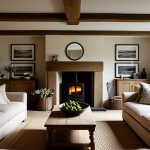Understanding the British Cottage Aesthetic
The British cottage design embodies a unique blend of warmth, charm, and historical depth. This architectural style is characterized by its traditional architecture, featuring thatched roofs, stone or brick exteriors, and quaint, symmetrical layouts. Inside, you’ll often find exposed wooden beams, cozy fireplaces, and snug spaces that speak to the intimate scale of classic elements.
Historically, cottages have been more than just picturesque dwellings; they represent a way of living that emphasizes comfort and practicality. Cottages were originally built for agricultural workers, which is why their design prioritizes functionality while retaining an undeniable charm. Their historical significance adds to their allure, making them coveted spots for those seeking a connection to the past.
Also read : Mastering conservatory foundations: overcoming clay soil challenges in the uk
When renovating these charming homes, it’s essential to preserve their traditional elements. This might include maintaining original fireplaces, restoring wooden beams, and using materials that resonate with the cottage’s era. By keeping these features intact, homeowners can respect the building’s heritage while subtly introducing modern conveniences.
Striking a balance between maintaining authentic touches and incorporating modern updates is key to preserving the classic elements of British cottage design. This thoughtful blend ensures that cottages remain timeless yet comfortably livable in today’s fast-paced world.
Also to discover : Revamp your uk home office: the ultimate guide to blending work efficiency with gaming delight
Planning Your Open-Concept Living Area
When planning an open-concept living area, it’s essential to first define the primary functions of the space. Consider how the area will be used daily—will it serve as a family gathering spot, a dining area, or perhaps a combination of both? Determining these functions helps in arranging your design around your household’s specific needs, ensuring a layout that maximizes both usability and comfort.
Next, assess the space constraints and opportunities present within your living area. Understanding the dimensions and potential limitations of your space can guide you in making informed decisions about furnishings and decor. Look for opportunities to enhance openness, such as integrating multi-purpose furniture or opting for wall-mounted solutions to free up floor space.
Creating a seamless flow between different functional zones is another crucial aspect of renovation planning. One effective strategy is to use visual cues, like area rugs or lighting fixtures, to subtly demarcate spaces without disrupting the overall openness. By doing so, you maintain the airy feel of an open concept while still defining distinct areas for various activities. This thoughtful approach to space optimization can transform your living area into a versatile and inviting environment.
Choosing Timeless Materials and Color Palettes
Selecting the right materials and color palettes is crucial in achieving a cohesive and elegant home interior. When considering flooring, cabinetry, and furnishings, focus on materials known for their durability and classic appeal. Hardwood floors offer a timeless option that complements both modern and traditional settings, while marble and granite provide sophistication in countertops and accents.
A carefully chosen color palette not only enhances the aesthetic appeal but also sets the mood of your home. Neutral tones such as beige, grey, and cream create a serene backdrop that is easily adaptable to various decor styles. Integrating deeper hues like navy or forest green can add depth and interest to the room, serving as an anchor for other design elements.
Incorporating natural elements elevates the warmth and classic appeal of your space. Use materials such as stone, wood, and linen to infuse a touch of nature indoors. These elements naturally harmonize with most design styles, providing a seamless blend of the natural environment with interior design. By thoughtfully integrating these elements, your home can exude both warmth and a timeless charm that withstands changing trends.
Design Principles for Sophisticated Living Spaces
Creating sophisticated interiors involves a keen understanding of key design principles that can transform any home into a haven of timeless elegance. The foundation of such interiors lies in balancing form and function, ensuring that every element serves a purpose while contributing to an overall aesthetic that feels both luxurious and inviting.
A crucial principle is achieving harmony among diverse furnishings and decor. This involves selecting pieces that not only complement each other but seamlessly blend different styles. For instance, pairing a sleek, modern sofa with a classic vintage coffee table can create a dynamic yet cohesive look. The contrast adds interest while maintaining a balance that prevents one style from overpowering the other.
Another aspect is balancing modern functionality with classic style. It’s essential to incorporate modern conveniences without sacrificing the traditional charm that defines a sophisticated space. Well-chosen lighting fixtures can highlight architectural features, while smart storage solutions hidden behind elegant exteriors keep spaces uncluttered, enhancing both functionality and aesthetic appeal.
Finally, consider the role of color palettes in elevating a space. While neutral tones can provide a serene backdrop, introducing rich accents like deep burgundy or royal blue can add layers of sophistication. These colors work as focal points, drawing the eye and creating areas of visual interest. By weaving these principles into your home, you can develop an environment that reflects your vision of sophisticated living.
Showcasing Successful Open-Concept Designs
Exploring open-concept examples offers a treasure trove of inspiration for those looking to merge modern layouts with traditional British cottage aesthetics. Through carefully crafted renovations, several case studies reveal how thoughtful design can breathe new life into classic spaces.
Case Study 1: A Modern Take on a Classic Cottage
In this renovation, the open-concept design transformed a quaint cottage into a luminous home by removing partition walls and embracing natural light. Key visual elements such as floor-to-ceiling windows allowed for a seamless indoor-outdoor connection, enhancing the cottage’s charm without compromising its historical roots. Using sliding doors and open shelving offered flexibility in the layout, demonstrating the power of space optimization.
Case Study 2: Blending Traditional and Contemporary Styles
This example showcased the art of merging classic elements with contemporary flair. While maintaining the cottage’s original fireplace and exposed beams, designers introduced sleek furniture and minimalist art, balancing the old and new. A neutral color palette, punctuated by bold accents, tied the decor together, illustrating how a cohesive look can be achieved through careful interior design choices.
Case Study 3: Enhancing Space with Thoughtful Design
Finally, this project focused on space optimization by employing multi-functional furniture and hidden storage solutions. Large mirrors expanded visual space, while strategically placed rugs defined different zones within the open-concept living area. The result was an inviting environment that felt both spacious and intimately connected, offering valuable lessons on maximizing compact areas.
These case studies exemplify how British cottage renovations can inspire others by blending tradition with modernity. Key strategies include leveraging architectural features, incorporating timeless materials, and applying well-thought-out design principles, resulting in spaces that are as functional as they are beautiful.
Final Touches and Home Styling
To transform a house into a home, focus on the finishing touches and thoughtful home styling techniques. Pay careful attention to selecting accessories that not only enhance the design but also harmonize with the overall aesthetic. Vases, artwork, and textiles can be used strategically to add charm and character, making spaces feel personal and inviting.
Lighting plays a pivotal role in creating a warm atmosphere. Opt for layered lighting solutions that allow for flexibility in mood setting. Using a combination of ambient, task, and accent lighting accentuates architectural features and creates an inviting ambiance throughout the home.
Personal touches are an essential element of home styling. Incorporate items that reflect the homeowner’s identity and preferences, such as family photographs, souvenirs, or bespoke furniture pieces. These elements create a narrative within the home, ensuring every space resonates with personality and life.





